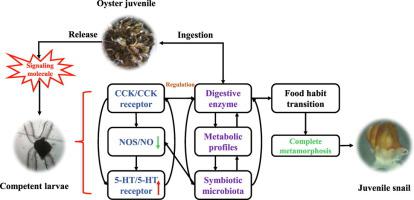Computational and Structural Biotechnology Journal ( IF 4.4 ) Pub Date : 2021-12-04 , DOI: 10.1016/j.csbj.2021.11.041 Mei-Jie Yang 1, 2, 3, 4, 5 , Hao Song 1, 2, 3, 4 , Jie Feng 1, 2, 3, 4 , Zheng-Lin Yu 1, 2, 3, 4 , Pu Shi 1, 2, 3, 4, 5 , Jian Liang 6 , Zhi Hu 1, 2, 3, 4, 5 , Cong Zhou 1, 2, 3, 4, 5 , Xiao-Lin Wang 1, 2, 3, 4 , Tao Zhang 1, 2, 3, 4, 7

|
Most marine mollusks have a pelagic larval phase, and they need to undergo metamorphosis to develop into adults. Metamorphosis is affected by many factors, including abiotic factors such as temperature, salinity and illumination as well as biological factors such as food and microorganisms. In our previous study, we found that the metamorphosis of Rapana venosa requires induction by juvenile oysters, which are the food source of R. venosa. However, the regulatory mechanism of this induction is largely unknown. In the present study, we evaluated the impacts of induction by juvenile oysters on competent larvae of R. venosa. Competent larvae were experimentally divided into two pools, and scallop shells without juvenile oysters and scallop shells with juvenile oysters were added for 2 h and 12 h to monitor alterations in critical gene expression, symbiotic microbiota and metabolomic responses. The carboxypeptidase gene was increased while the cellulase gene was decreased, which may mean that the food habit transition was induced by juvenile oysters. Meanwhile, critical genes in the neuroendocrine system were also significantly altered in juvenile oysters. Furthermore, dramatic changes in the symbiotic microbiota and metabolism profiles were observed, with many of them associated with the digestive system and neuroendocrine system. In conclusion, juveniles as food resources may induce metamorphosis in R. venosa by regulating the neuroendocrine system and promoting the development of the digestive system and changes in digestive enzymes. This study may provide evidence that induction by juvenile oysters can promote food habit transition and metamorphosis in R. venosa by regulating the metabolome and microbiome and further altering the digestive and neuroendocrine systems of R. venosa, which expands our understanding of the regulatory mechanism of metamorphosis in R. venosa. However, further studies are needed to explore the specific substance inducing metamorphosis released by juvenile oysters.
中文翻译:

共生微生物组和代谢谱揭示牡蛎诱导对肉食性腹足动物 Rapana venosa 变态的影响
大多数海洋软体动物具有远洋幼体阶段,它们需要经历变态才能发育成成体。变态受多种因素影响,包括温度、盐度、光照等非生物因素,以及食物、微生物等生物因素。在我们之前的研究中,我们发现Rapana venosa的变态需要幼牡蛎的诱导,这是R. venosa的食物来源。然而,这种诱导的调节机制在很大程度上是未知的。在本研究中,我们评估了幼牡蛎诱导对R. venosa 有能力的幼虫的影响. 实验上将有能力的幼虫分成两个池,分别加入不含幼牡蛎的扇贝壳和含幼牡蛎的扇贝壳分别培养 2 小时和 12 小时,以监测关键基因表达、共生微生物群和代谢组学反应的变化。羧肽酶基因增加而纤维素酶基因减少,这可能意味着幼牡蛎诱导了食性转变。同时,幼牡蛎中神经内分泌系统的关键基因也发生了显着变化。此外,观察到共生微生物群和代谢谱发生了巨大变化,其中许多与消化系统和神经内分泌系统有关。综上所述,幼鱼作为食物资源可能会诱发R. venosa的变态通过调节神经内分泌系统,促进消化系统的发育和消化酶的变化。本研究可能提供证据表明,牡蛎幼年的诱导可以通过调节R. venosa的代谢组和微生物组,并进一步改变R. venosa的消化和神经内分泌系统来促进R. venosa的饮食习性转变和变态,从而扩展我们对变态调控机制的理解。在R. venosa。然而,还需要进一步的研究来探索幼牡蛎释放的特定物质导致变态。











































 京公网安备 11010802027423号
京公网安备 11010802027423号